
Myliobatiformes is one of the four orders of batoids, cartilaginous fishes related to sharks. They were formerly included in the order Rajiformes, but more recent phylogenetic studies have shown the myliobatiforms to be a monophyletic group, and its more derived members evolved their highly flattened shapes independently of the skates.
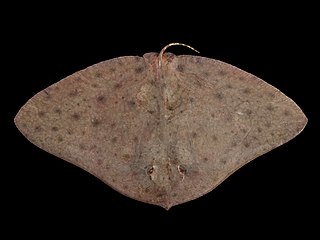
The butterfly rays are the rays forming the genus Gymnura and the family Gymnuridae. They are found in warm oceans worldwide, and occasionally in estuaries.

The Urolophidae are a family of rays in the order Myliobatiformes, commonly known as stingarees or round stingrays. This family formerly included the genera Urobatis and Urotrygon of the Americas, which are presently recognized as forming their own family Urotrygonidae. Stingarees are found in the Indo-Pacific region, with the greatest diversity off Australia. They are sluggish, bottom-dwelling fish that have been recorded from shallow waters close to shore to deep waters over the upper continental slope. Measuring between 15 and 80 cm long, these rays have oval to diamond-shaped pectoral fin discs and relatively short tails that terminate in leaf-shaped caudal fins, and may also have small dorsal fins and lateral skin folds. Most are smooth-skinned, and some have ornate dorsal color patterns.

The sixgill stingray is a species of stingray and the only extant member of the family Hexatrygonidae. Although several species of sixgill stingrays have been described historically, they may represent variations in a single, widespread species. This flabby, heavy-bodied fish, described only in 1980, is unique among rays in having six pairs of gill slits rather than five. Growing up to 1.7 m (5.6 ft) long, it has a rounded pectoral fin disc and a long, triangular, and flexible snout filled with a gelatinous substance. It is brownish above and white below, and lacks dermal denticles.

The deepwater stingray or giant stingaree is a species of stingray and the sole member of the family Plesiobatidae. It is widely distributed in the Indo-Pacific, typically over fine sediments on the upper continental slope at depths of 275–680 m (900–2,230 ft). This species reaches 2.7 m (8.9 ft) in length and 1.5 m (4.9 ft) in width. It has an oval pectoral fin disc with a long, flexible, broad-angled snout. Most of the entire latter half of its tail supports a distinctively long, slender, leaf-shaped caudal fin. Its coloration is dark above and white below, and its skin is almost completely covered by tiny dermal denticles.

The Atlantic stingray is a species of stingray in the family Dasyatidae, common along the Atlantic coast of North America from Chesapeake Bay to Mexico, including brackish and freshwater habitats. It may be distinguished from other stingrays in the area by its relatively elongated snout. This species is of little commercial importance, other than for sale in the aquarium industry.

The pelagic stingray is a species of stingray in the family Dasyatidae, and the sole member of its genus. It is characterized by the wedge-like shape of its pectoral fin disc, which is much wider than long, as well as by the pointed teeth in both sexes, whip-like tail with extremely long tail spine, and uniform violet to blue-green coloration. It generally reaches 59 cm (23 in) in width. The pelagic stingray has a worldwide distribution in waters warmer than 19 °C (66 °F), and migrates seasonally to spend the summer closer to the continental shelf and at higher latitudes. The only stingray that almost exclusively inhabits the open ocean, this species is typically found in surface waters down to a depth of 100 m (330 ft). As a consequence of its midwater habits, its swimming style has evolved to feature more of a flapping motion of the pectoral fins, as opposed to the disc margin undulations used by other, bottom-dwelling stingrays.
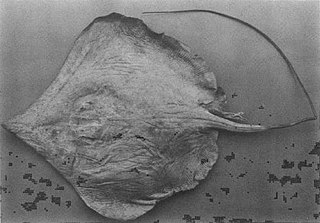
The sharpnose stingray is a little-known species of stingray in the family Dasyatidae, found off southern Japan and in the East China Sea. With a rounded pectoral fin disc and a long, projecting snout, T. acutirostra resembles the smaller pale-edged stingray. A number of characteristics differentiate this species from T. zugei, including larger eyes and the absence of a dorsal fin fold on the tail. The International Union for Conservation of Nature (IUCN) has assessed this species as Near Threatened, as its restricted distribution renders it vulnerable to increases in fishing pressure.

The diamond stingray is a species of stingray in the family Dasyatidae. It is found in the coastal waters of the eastern Pacific Ocean from southern California to northern Chile, and around the Galápagos and Hawaiian Islands. This bottom-dweller generally inhabits sandy or muddy flats near rocky reefs and kelp forests, to a depth of 30 m (98 ft), though off Hawaii it may range considerably deeper. As its common name suggests, this species has an angular, diamond-shaped pectoral fin disc that is plain brown or gray above, with rows of tubercles along the midline and on the "shoulders". The long, whip-like tail has both dorsal and ventral fin folds, which distinguish this ray from the closely similar longtail stingray. It typically grows to 1 m (3.3 ft) across.

The longnose stingray is a species of stingray in the family Dasyatidae, native to the western Atlantic Ocean from the southern Gulf of Mexico to Brazil. Found in coastal waters no deeper than 36 m (118 ft), this demersal species favors muddy or sandy habitats. The longnose stingray is characterized by its angular, rhomboid pectoral fin disc, moderately projecting snout, and whip-like tail with a dorsal keel and ventral fin fold. It typically grows to 1.25 m (4.1 ft) across and is brownish above and light-colored below.

The bluntnose stingray or Say's stingray is a species of stingray in the family Dasyatidae, native to the coastal waters of the western Atlantic Ocean from the U.S. state of Massachusetts to Venezuela. It is a bottom-dwelling species that prefers sandy or muddy habitats 1–10 m (3.3–32.8 ft) deep, and is migratory in the northern portion of its range. Typically growing to 78 cm (31 in) across, the bluntnose stingray is characterized by a rhomboid pectoral fin disc with broadly rounded outer corners and an obtuse-angled snout. It has a whip-like tail with both an upper keel and a lower fin fold, and a line of small tubercles along the middle of its back.
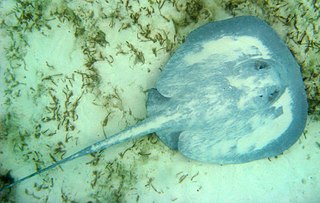
The chupare stingray or Caribbean whiptail stingray is a species of stingray in the family Potamotrygonidae, found in the western Atlantic Ocean from the Gulf of Campeche to Brazil, including the Antilles. The presence of this species in the Gulf of Mexico has not been confirmed. It also occurs in the Bahamas. It usually inhabits sandy substrates, sometimes near coral reefs, and is an infrequent visitor to the Amazon River estuary. Leonard Compagno doubted the taxonomic validity of this species in his 1999 Checklist of Living Elasmobranchs.
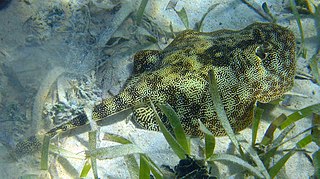
The yellow stingray is a species of stingray in the family Urotrygonidae, found in the tropical western Atlantic Ocean from North Carolina to Trinidad. This bottom-dwelling species inhabits sandy, muddy, or seagrass bottoms in shallow inshore waters, commonly near coral reefs.
The pincushion ray or thorny freshwater stingray, is a little-known species of stingray in the family Dasyatidae, found in the rivers and lakes of West and Middle Africa. A heavy-bodied ray measuring up to 1.2 m (4 ft) across, this species can be distinguished by its rounded pectoral fin disk, reduced or absent stinging tail spine, and—in adults—numerous stout thorns covering its back and tail. In lieu of a long tail spine as in other stingrays, the pincushion ray employs these thorny denticles in defense. Seldom encountered since it was originally described, this species has been assessed as Critically Endangered by the International Union for Conservation of Nature (IUCN).

The Tumbes round stingray is a little-known species of round ray, family Urolophidae, known only from two immature male specimens collected from estuarine waters at depths of 1–2 m, and a third specimen collected in 2006 near mangroves. Its range appears to be limited to coastal waters off Tumbes in northern Peru, where it is found partially buried in sand or mud. The larger of the original two specimens measured 40.4 cm long and the smaller 15.7 cm.

The common stingray is a species of stingray in the family Dasyatidae, found in the northeastern Atlantic Ocean and the Mediterranean and Black Seas. It typically inhabits sandy or muddy habitats in coastal waters shallower than 60 m (200 ft), often burying itself in sediment. Usually measuring 45 cm (18 in) across, the common stingray has a diamond-shaped pectoral fin disc slightly wider than long, and a whip-like tail with upper and lower fin folds. It can be identified by its plain coloration and mostly smooth skin, except for a row of tubercles along the midline of the back in the largest individuals.

The round fantail stingray or round stingray, is a poorly known species of stingray in the family Dasyatidae. It inhabits sandy, muddy, or rocky coastal habitats in the eastern Atlantic Ocean and the southern Mediterranean Sea. This dark-colored ray typically reaches a width of 1 m (3.3 ft), and can be identified by its nearly circular pectoral fin disk, short tail, and mostly bare skin. The round fantail stingray hunts for fishes and crustaceans on the sea floor, and exhibits an aplacental viviparous mode of reproduction. The International Union for Conservation of Nature (IUCN) does not yet have sufficient information to assess the conservation status of this species.

Batomorphi is a clade of cartilaginous fishes, commonly known as rays, this taxon is also known as the superorder Batoidea, but the 5th edition of Fishes of the World classifies it as the division Batomorphi. They and their close relatives, the sharks, compose the subclass Elasmobranchii. Rays are the largest group of cartilaginous fishes, with well over 600 species in 26 families. Rays are distinguished by their flattened bodies, enlarged pectoral fins that are fused to the head, and gill slits that are placed on their ventral surfaces.
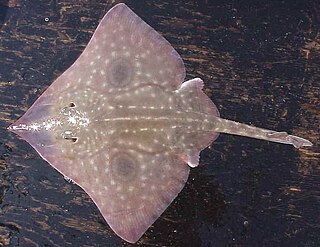
Beringraja is a genus of skates in the family Rajidae with up to six described species. Formerly, they were included in the genus Raja until 2012, when the genus Beringraja was erected for the two species which had multiple embryos per egg capsule. Genetic evidence has led to four additional species being proposed for inclusion in the genus, although this issue has not be completely resolved. These large skates are found in the North Pacific.


















